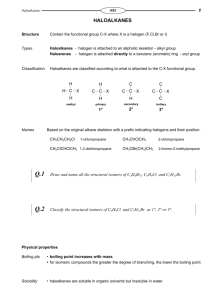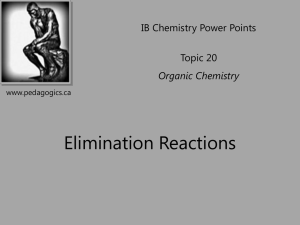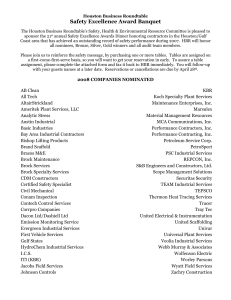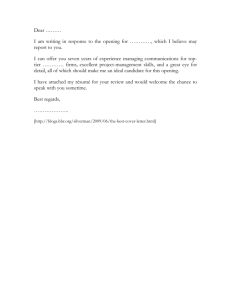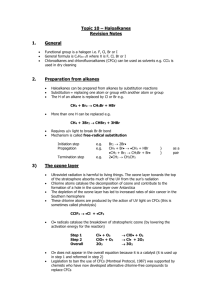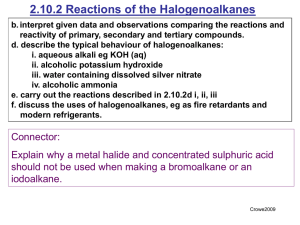halogenoalkanes
advertisement
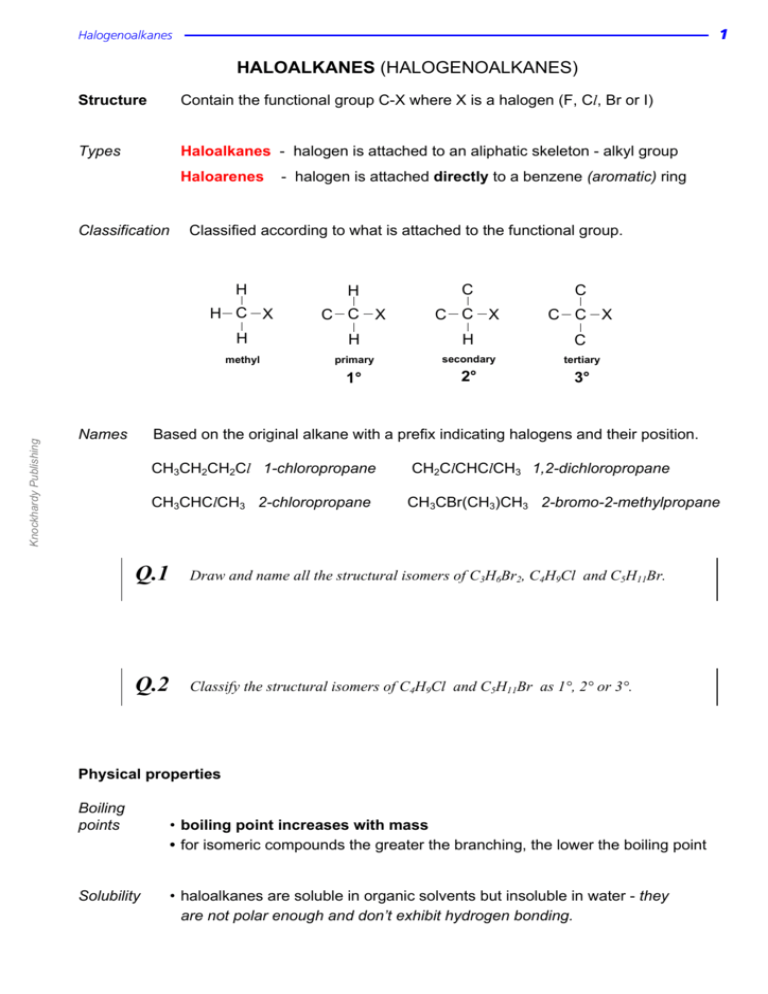
1 Halogenoalkanes HALOALKANES (HALOGENOALKANES) Structure Contain the functional group C-X where X is a halogen (F, Cl, Br or I) Types Haloalkanes - halogen is attached to an aliphatic skeleton - alkyl group Haloarenes Knockhardy Publishing Classification Names - halogen is attached directly to a benzene (aromatic) ring Classified according to what is attached to the functional group. H H C C H C X C C X C C X C C X H H H C methyl primary secondary tertiary 1° 2° 3° Based on the original alkane with a prefix indicating halogens and their position. CH3CH2CH2Cl 1-chloropropane CH2ClCHClCH3 1,2-dichloropropane CH3CHClCH3 2-chloropropane CH3CBr(CH3)CH3 2-bromo-2-methylpropane Q.1 Draw and name all the structural isomers of C3H6Br2, C4H9Cl and C5H11Br. Q.2 Classify the structural isomers of C4H9Cl and C5H11Br as 1°, 2° or 3°. Physical properties Boiling points Solubility • boiling point increases with mass • for isomeric compounds the greater the branching, the lower the boiling point • haloalkanes are soluble in organic solvents but insoluble in water - they are not polar enough and don’t exhibit hydrogen bonding. © KNOCKHARDY PUBLISHING 2015 2 Halogenoalkanes NUCLEOPHILIC SUBSTITUTION REACTIONS Theory δ+ • halogens have a greater electronegativity than carbon • a dipole is induced in the C-X bond and it becomes polar C δ− Br polarity in a C-Br bond • the carbon is thus open to attack by nucleophiles Nucleophiles • examples are OH¯, CN¯, NH3 and H2O • possess at least one LONE PAIR of electrons • are attracted to the slightly positive (electron deficient) carbon Basic mechanism • the nucleophile uses its lone pair to provide the electrons for a new bond • as carbon can only have 8 electrons in its outer shell a halide ion is displaced • the result is substitution following attack by a nucleophile H Rate of reaction H H C C H H H Br H C C H H Nu + 238 kJmol-1 ........... 276 kJmol-1 C-Br ........... 338 C-Cl ........... kJmol-1 484 kJmol-1 C-F ........... least polar WEAKEST BOND EASIEST TO BREAK FASTEST REACTION most polar The time taken for a precipitate of silver halide is measured. The faster the precipitate forms, the faster the hydrolysis and the weaker the C-X bond. • warm equal amounts of each haloalkane in a water bath • add a solution of ethanol, water and aqueous silver nitrate to each • record the time it takes for a precipitate to appear AgCl - white AgBr - cream AgI - yellow © KNOCKHARDY PUBLISHING 2015 - : Br: • the rate of reaction depends on the strength not the polarity of the C-X bond C-I Practical investigation H (AgF is soluble) Knockhardy Publishing Nu:- : : • the mechanism is therefore known as - NUCLEOPHILIC SUBSTITUTION 3 Halogenoalkanes NaOH Reagent AQUEOUS sodium (or potassium) hydroxide Conditions Reflux in aqueous solution Product Alcohol Nucleophile hydroxide ion (OH¯) Equation e.g. C2H5Br(l) + NaOH(aq) (SOLVENT IS IMPORTANT) ——> C2H5OH(l) + NaBr(aq) H H H C C H H WARNING H Br H H C C H H OH + : : : : HO: : : Mechanism - : Br: It is important to quote the solvent when answering questions. Elimination takes place when ethanol is the solvent. Knockhardy Publishing This reaction (and the one with water) is sometimes known as HYDROLYSIS H2O • A similar reaction to the above but SLOWER because... a) the liquids are immiscible - less chance of molecules colliding b) water is a poor nucleophile • faster reaction in an alcohol/water mixture; miscible = more collisions Equation AgNO3 (aq/alc) e.g. C2H5Br(l) + H2O(l) ——> C2H5OH(aq/alc) + HBr(aq) Used to identify the halide in a haloalkane - see above Q.3 Write equations for the reactions of hot, aqueous NaOH with... a) CH3CH2CH2 Br b) CH3CHBrCH2CH3 c) Advanced work (CH3)3CBr This form of nucleophilic substitution discussed so far is known as SN2; it is a bimolecular process. An alternative method involves the initial breaking of the C-X bond to form a carbocation, or carbonium ion, (a unimolecular process - SN1 mechanism), which is then attacked by the nucleophile. SN1 is favoured for tertiary haloalkanes where there is steric hindrance to the attack and a more stable tertiary, 3°, carbocation intermediate is formed. © KNOCKHARDY PUBLISHING 2015 4 Halogenoalkanes KCN Reagent Aqueous, alcoholic potassium (or sodium) cyanide Conditions Reflux in aqueous, alcoholic solution Product Nitrile (cyanide) Nucleophile cyanide ion (CN¯) Equation C2H5Br + KCN(aq/alc) ——> C2H5CN + KBr N C :H Importance H C C H H H Br H H C C H H + CN : Br: - extends the carbon chain by one carbon atom as the CN group can then be converted to carboxylic acids or amines Hydrolysis C2H5CN + 2H2O Reduction C2H5CN + 4[H] ——> ——> C2H5COOH + NH3 C2H5CH2NH2 Reagent Aqueous, alcoholic ammonia (in EXCESS) Conditions Reflux in aqueous, alcoholic solution under pressure Product Amine (or its salt due to a reaction with the acid produced) Nucleophile Ammonia (NH3) Equation C2H5Br + NH3 (aq/alc) ——> C2H5NH2 + HBr HBr + NH3(aq/alc) ——> NH4Br C2H5Br + 2NH3(aq/alc) ——> C2H5NH2 + NH4Br Knockhardy Publishing NH3 H : : Mechanism Mechanism H H H C C H Br H H H H C C H H H + N H + - : Br: H H H C C H H : H : : H H N: H N H2 + HBr Why the excess ammonia? The second ammonia molecule ensures the removal of HBr which would lead to the formation of a salt. A large excess of ammonia ensures further substitution doesn’t take place © KNOCKHARDY PUBLISHING 2015 5 Halogenoalkanes Problem The amine produced is also a nucleophile (lone pair on the N) and can attack another molecule of haloalkane to produce a 2° amine. This in turn is a nucleophile and can react further producing a 3° amine and, eventually an ionic quarternary ammonium salt. C2H5NH2 + C2H5Br —> HBr + (C2H5)2NH diethylamine, a 2° amine (C2H5)2NH + C2H5Br —> HBr + (C2H5)3N triethylamine, a 3° amine (C2H5)3N —> (C2H5)4N+ Br¯ + C2H5Br tetraethylammonium bromide, (a 4° salt) OTHER REACTIONS OF HALOALKANES Knockhardy Publishing Friedel Crafts alkylation substitutes an alkyl (e.g. methyl, ethyl) group onto a benzene ring reagents a haloalkane (RX) and anhydrous aluminium chloride AlCl3 conditions room temperature; dry inert solvent (ether) mechanism electrophilic substitution electrophile a carbocation ion R+ (e.g. CH3+) equation C2H5Br + C6H6 AlCl3 ——> C6H5C2H5 + HBr see notes on benzene Preparation of haloalkanes - Summary (details can be found in other sections) From alkanes CH4 + Cl2 —> CH3Cl + HCl alkenes C2H4 + HBr —> alcohols C2H5OH + HBr —> C2H5Br + H2O C2H5Br © KNOCKHARDY PUBLISHING 2015 Free radical substitution / UV light Electrophilic addition / no catalyst or UV Protonation of alcohol with acid catalyst 6 Halogenoalkanes USES OF HALOALKANES Synthetic The reactivity of the C-X bond means that haloalkanes play an important part in synthetic organic chemistry. The halogen can be replaced by a variety of groups via a nucleophilic substitution mechanism. During the manufacture of ibuprofen, substitution of a bromine atom takes place. Monomers Polymers CFC’s chloroethene CH2 = CHCl tetrafluoroethene CF2 = CF2 poly(chloroethene) PVC —(CH2 — CHCl)n— packaging poly(tetrafluoroethene) PTFE —(CF2 — CF2)n— non-stick surfaces CHFCl2 CF3Cl refrigerant aerosol propellant blowing agent bromochlorodifluoromethane CBrClF2 fire extinguishers CCl2FCClF2 dry cleaning solvent degreasing agent All the above were chosen because of their... • low reactivity • volatility • non-toxicity PROBLEMS WITH CFC’s Ozone layer • CFC’s have been blamed for environmental damage by thinning the ozone layer • Ozone absorbs a lot of harmful UV radiation • CFC’s break up in the atmosphere to form free radicals CF2Cl2 ——> •CF2Cl + •Cl • free radicals catalyse ozone decomposition e.g. •Cl + O3 ——> •ClO + O2 •ClO + O ——> •Cl + O2 • overall Solution 2O3 ——> 3O2 • CFC’s were designed by chemists to help people • chemists now synthesise alternatives to CFC’s to protect the environment such as hydrocarbons and HCFC’s • CO2 can be use as an alternative blowing agent • this will allow the reversal of the ozone layer problem © KNOCKHARDY PUBLISHING 2015 Knockhardy Publishing dichlorofluoromethane trichlorofluoromethane 7 Halogenoalkanes ELIMINATION REACTIONS OF HALOALKANES Problem Reaction The products of reactions between haloalkanes and OH¯ are influenced by the solvent. Both mechanisms take place simultaneously but the choice of solvent favours one route. Solvent Product Action of OH¯ Mechanism WATER ALCOHOL NUCLEOPHILE SUBSTITUTION ALCOHOL ALKENE BASE ELIMINATION Reagent Conditions Product Mechanism Equation Alcoholic sodium (or potassium) hydroxide Reflux in alcoholic solution Alkene Elimination C3H7Br + NaOH(alc) ——> C3H6 + H2O + NaBr CH3 • • • • • Q.4 H H δ+ C C H H H H δ− C Br CH3 + C H2O + : : : HO:- - : Br: : Knockhardy Publishing Mechanism H the OH¯ ion acts as a base and picks up a proton the proton comes from a carbon atom next to the one bonded to the halogen the electron pair left moves to form a second bond between the carbon atoms the halide ion is displaced overall there is ELIMINATION of HBr. What organic products are formed when concurrent substitution and elimination takes place with CH3CHBrCH3 ? Complication The OH¯ removes a proton from a carbon atom adjacent the C bearing the halogen. If there had been another carbon atom on the other side of the C-X, its hydrogen(s) would also be open to attack. If the haloalkane is unsymmetrical (e.g. 2-bromobutane) a mixture of isomeric alkene products is obtained. Q.5 What organic products do you get with alcoholic NaOH and CH3CHBrCH2CH3 ? Explain your answers with a mechanism. © KNOCKHARDY PUBLISHING 2015
